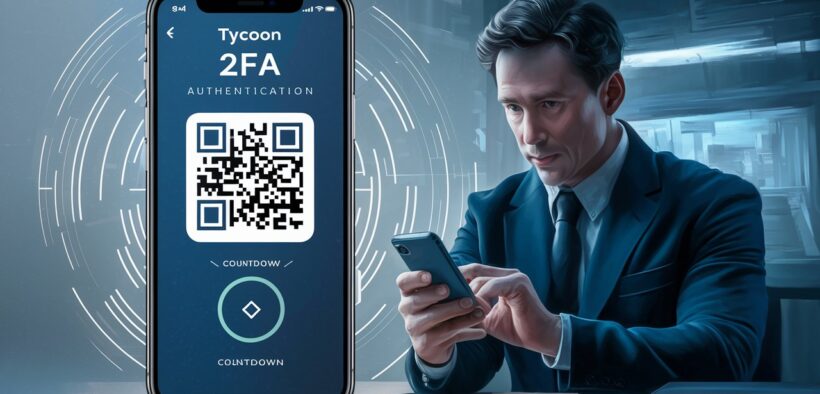Tycoon 2FA Phishing Kit Bypasses MFA, Steals Credentials for Microsoft 365, Gmail Accounts
Share

Cybercriminals are launching sophisticated attacks against Microsoft 365 and Gmail users with a new and dangerous phishing kit called Tycoon 2FA. This tool poses a serious threat because it bypasses two-factor authentication (MFA), a security measure many users rely on to protect their accounts.
Tycoon 2FA: Multi-Stage Deception
Security researchers at Sekoia discovered Tycoon 2FA in October 2023, but evidence suggests it’s been operational since at least August 2023. The attack unfolds in several cunning stages:
- Luring the Victim: The attacker initiates the scam by sending emails containing malicious links or QR codes. Clicking on these leads the victim to a deceptive login page designed to mimic Microsoft’s authentic login portal.
- Thwarting Bots: To ensure they target real users, the phishing page incorporates a security challenge, such as the widely used Cloudflare Turnstile. This challenge blocks automated bots often used to launch large-scale phishing campaigns.
- Personalization for Trust: Once a human user interacts with the page, malicious scripts extract the victim’s email address from the URL. This information is then used to personalize the fake login page, making it appear even more legitimate and increasing the chance of the victim entering their credentials.
- Stealing Credentials Covertly: A convincing Microsoft login page appears, designed to steal the victim’s username and password. To achieve this, the attackers leverage WebSockets, a technology that enables real-time data exchange between the web page and the server. This allows the stolen credentials to be transmitted discreetly in the background.
- Bypassing the Extra Layer of Security: Perhaps most worryingly, Tycoon 2FA incorporates a fake 2FA challenge. This tricks the user into revealing the additional security code generated by their authentication app or sent via SMS, effectively bypassing the crucial second layer of protection offered by MFA.
- Maintaining the Illusion: After the victim falls for the deception and enters their credentials and 2FA code, they are redirected to a legitimate-looking webpage. This final step is designed to lull the victim into a false sense of security, making them believe they have successfully logged in.
Tycoon 2FA’s Stealthy Evolution
Sekoia reported a significant update in 2024, making Tycoon 2FA even more deceptive and difficult to detect. These updates demonstrate the ongoing development efforts behind this malicious kit and highlight the need for users to stay vigilant. Here’s a look at some of the key improvements incorporated by the attackers:
- Code Obfuscation: The code behind Tycoon 2FA has been altered to make it more complex and harder for security researchers to identify its malicious functionality.
- Delayed Loading of Malicious Resources: The phishing kit now waits until the user successfully completes the initial security challenge before loading the malicious resources that steal their credentials. This delays detection by security software that scans for suspicious activity on web pages.
- URL Camouflage: The kit now uses nonsensical names for URLs, making them appear less suspicious and reducing the chance of users noticing something out of the ordinary.
- Advanced Bot Filtering: The attackers have implemented improved methods to detect and block automated bots. This includes identifying traffic originating from the Tor anonymizing network, data center IP addresses, and specific user-agent strings associated with bots.
The Lucrative Business of Phishing
The scale of Tycoon 2FA’s operation is alarming. A Bitcoin wallet linked to the operators shows a substantial increase in activity since the kit’s launch in August 2023. By March 2024, the wallet had received over $394,000 worth of cryptocurrency, highlighting the profitability of these phishing schemes for cybercriminals.
Tycoon 2FA and the Growing Phishing Threat Landscape
Tycoon 2FA is just one example of a disturbing trend in Phishing-as-a-Service (PhaaS) platforms. These readily available tools lower the barrier to entry for cybercriminals, allowing even those with limited technical expertise to launch sophisticated phishing attacks. Other well-known PhaaS platforms include LabHost, Greatness, and Robin Banks, all offering similar capabilities to bypass MFA protections.
Staying Secure in the Face of Evolving Phishing Tactics
With these evolving phishing threats, vigilance is critical. Here are some essential tips to stay safe:
- Scrutinize Emails with Caution: Don’t click on links or open attachments from unknown senders. Be wary of emails that create a sense of urgency or pressure you to take immediate action.
Verify URLs Before You Login: Double-check the legitimacy of a web address before entering your credentials on any login page. Look for typos or inconsistencies in the URL that might indicate a phishing attempt.
- Enable Multi-Factor Authentication (MFA) Whenever Possible: While not foolproof, MFA adds an extra layer of security that can significantly hinder attackers, even if they bypass other security measures.
- Use Strong, Unique Passwords: Avoid using the same password for multiple accounts. Consider using a password manager to generate and store strong, unique passwords for all your online accounts.
- Stay Informed: Keep yourself updated on the latest phishing tactics and best practices for online security. Security blogs, reputable news sources, and cybersecurity companies often publish informative articles and resources to help users stay informed about the latest threats.
By following these steps and remaining cautious, you can significantly reduce the risk of falling victim to a phishing attack, even against advanced tools like Tycoon 2FA.



Your point of view caught my eye and was very interesting. Thanks. I have a question for you.
Your point of view caught my eye and was very interesting. Thanks. I have a question for you.